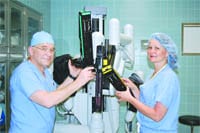Beyond Cosmetics New Research Confirms That Botox Helps Children With Cerebral Palsy
The story of Botox just got a new wrinkle.
While Botox — or botulinium toxin — has become popular with celebrities and average folk alike for its ability to smooth out facial wrinkles, researchers from the Walter Reed Army Medical Center in Washington, D.C. have confirmed a new use for the product: easing the effects of cerebral palsy in children.
According to lead researcher Dr. Marc DiFazio, botulinum toxin type A helps improve movement in children who have the neurological disorder. That had been a suspected outcome for some time; however, the safety aspect had clearly been in question. Not anymore.
“The most important part of the study was not so much that we were demonstrating improvement in the kids, but that we demonstrated that this medication is really safe,” said DiFazio, who presented his findings last month at the American Academy of Neurology’s annual meeting in Honolulu.
The impact is clear simply in the numbers. As many as 500,000 Americans have cerebral palsy, according to the National Institute of Neurological Disorders and Stroke, and 4,500 babies are diagnosed with the disease every year.
“It’s great news for families of children with cerebral palsy that long-term botulinium toxin is safe,” DiFazio said.
The Bright Side of Botulism
It’s one of the ironies of medicine that potentially dangerous products may be put to highly beneficial use. The April issue of The Healthcare News carried a story about MicroTest Laboratories in Agawam and its efforts to develop a vaccine against botulinium toxin, which is associated with food poisoning and has the potential to be used in bioterrorism.
Yes, the Botox injections that have been used for cosmetic purposes — and are expected to make a difference for cerebral palsy sufferers — is derived from the same bacterium that causes food poisoning. A high dose of the toxin can indeed be fatal — it kills by paralyzing the muscles used for breathing — but the dose is given in injections so small that harmful side effects are unlikely, according to the American Association of Family Physicians.
For some time, Botox injections have been used not only as a wrinkle deterrent, but to treat muscle spasms in the face or eyelid, or to combat certain eye movement disorders, such as a lazy eye. Botulinium toxin is also a standard treatment for spasmodic torticollis, a muscle spasm that causes the head and neck to pull in one direction.
The reason for these applications is that botulinium toxin stops some of the chemical messages that are sent from nerves that tell the muscles to contract in spasms. Botulinum toxin is used to stop muscle spasms because it blocks these messages.
From these successes, it was only a short jump to treating cerebral palsy. The condition, triggered by damage to a child’s developing brain, causes abnormal stiffness, odd postures, and uncontrollable movements. In severe cases, children may be unable to walk or control the movement of their limbs. According to DiFazio, Botox helps by interrupting the communication between the nerves and the spinal cord, which lets muscles relax.
Scientists in Washington studied 250 children between the ages of 1 and 16 who received Botox injections for cerebral palsy. Of those studied for an average of two years, 92{06cf2b9696b159f874511d23dbc893eb1ac83014175ed30550cfff22781411e5} maintained their favorable response to the drug. In addition, 80{06cf2b9696b159f874511d23dbc893eb1ac83014175ed30550cfff22781411e5} of children followed for more than two years continued to show improvement over their initial symptoms.
“It’s very exciting to see the progress these kids can make,” DiFazio said. “Some of them are able to do more for themselves, like feeding themselves or turning on a faucet. Some were able to hold a pen and write for the first time, or use a computer touch screen to communicate. These may not seem like big changes, but they can be life-changing for these kids and their families.”
Surprisingly, the results appear to last longer than the medication does. Even though Botox wears off in about three to four months, requiring additional treatments for its other uses, DiFazio said many of the children were still seeing improvements six to nine months later — perhaps because, once they were able to use their muscles, those muscles became stronger and more flexible.
Also of note, he said, is that the children who received more than one treatment exhibited no evidence that they were building up a tolerance to the medication.
There were side effects in the study, but they were mild and uncommon. Only 2{06cf2b9696b159f874511d23dbc893eb1ac83014175ed30550cfff22781411e5} showed side effects, including flu-like symptoms and mild weakness in the legs.
any older medications used to treat muscle spasms and stiffness have significant side effects, such as drowsiness and cognitive impairment, DiFazio noted.
Safety First
The safety issue is paramount to DiFazio and other researchers because it will ease the acceptance of Botox as a cerebral palsy treatment into the medical establishment. That’s a major development for a toxin that has mainly been associated with looking younger; Celine Dion, Cher, and Madonna are just three celebrities rumored to have had Botox treatment.
Although the use of Botox has since spread to encompass treating paralysis after a stroke, migraine headaches, back pain, writer’s cramp, and muscle spasms, this new application is perhaps the most significant, DiFazio said.
“We have opened up a whole new world for these children,” he said. “Parents of children with cerebral palsy need to know that there are options. We have taken a giant leap forward in the past decade.”
“We’ve known for a long time that Botox is very effective for children with spasticity,” said Dr. Jay Van Gerpen, a neurologist and director of the movement disorder section at the Ochsner Clinic Foundation in New Orleans, adding that DiFazio’s study confirms what many had already believed. “Botox has serious medical applications. It’s not just for crow’s feet.”
Information in this article came from HealthScout News, the American Academy of Family Physicians, and the American Academy of Pediatrics


